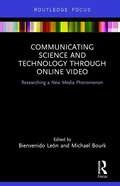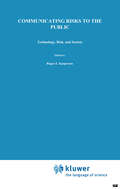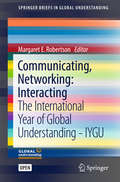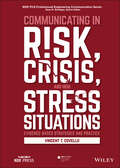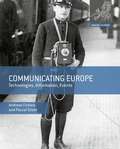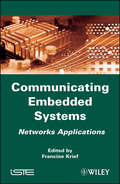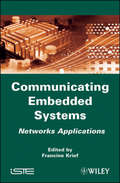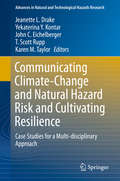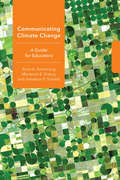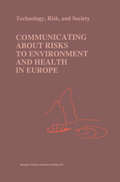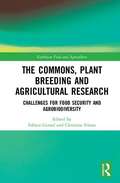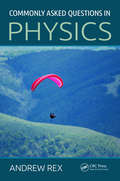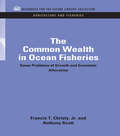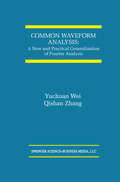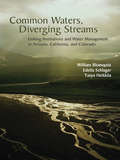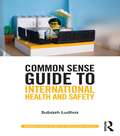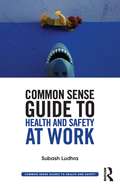- Table View
- List View
Communicating Science And Technology Through Online Video: Researching A New Media Phenomenon (Routledge Focus On Communication Studies (PDF))
by Bienvenido León Michael BourkOnline video’s unique capacity to reach large audiences makes it a powerful tool to communicate science and technology to the general public. The outcome of the international research project "Videonline," this book provides a unique insight into the key elements of online science videos, such as narrative trends, production characteristics, and issues of scientific rigor. If offers various methodological approaches: a literature review, content analysis, and interviews and surveys of expert practitioners to provide information on how to maintain standards of rigour and technical quality in video production.
Communicating Science And Technology Through Online Video: Researching A New Media Phenomenon (Routledge Focus On Communication Studies (PDF))
by Bienvenido León Michael BourkOnline video’s unique capacity to reach large audiences makes it a powerful tool to communicate science and technology to the general public. The outcome of the international research project "Videonline," this book provides a unique insight into the key elements of online science videos, such as narrative trends, production characteristics, and issues of scientific rigor. If offers various methodological approaches: a literature review, content analysis, and interviews and surveys of expert practitioners to provide information on how to maintain standards of rigour and technical quality in video production.
Communicating Risks to the Public: International Perspectives (Risk, Governance and Society #4)
by Pieter Jan M.Stallen Roger E. KaspersonRisk communication: the evolution of attempts Risk communication is at once a very new and a very old field of interest. Risk analysis, as Krimsky and Plough (1988:2) point out, dates back at least to the Babylonians in 3200 BC. Cultures have traditionally utilized a host of mecha nisms for anticipating, responding to, and communicating about hazards - as in food avoidance, taboos, stigma of persons and places, myths, migration, etc. Throughout history, trade between places has necessitated labelling of containers to indicate their contents. Seals at sites of the ninth century BC Harappan civilization of South Asia record the owner and/or contents of the containers (Hadden, 1986:3). The Pure Food and Drug Act, the first labelling law with national scope in the United States, was passed in 1906. Common law covering the workplace in a number of countries has traditionally required that employers notify workers about significant dangers that they encounter on the job, an obligation formally extended to chronic hazards in the OSHA's Hazard Communication regulation of 1983 in the United States. In this sense, risk communication is probably the oldest way of risk manage ment. However, it is only until recently that risk communication has attracted the attention of regulators as an explicit alternative to the by now more common and formal approaches of standard setting, insuring etc. (Baram, 1982).
Communicating, Networking: The International Year of Global Understanding - IYGU (SpringerBriefs in Global Understanding)
by Margaret E. RobertsonThis book illustrates the benefits to be gained from digitally networked communication for health, education and transitioning economies in developing nations (Sierra Leone and Papua New Guinea) and developed nations. Growing powers of e-citizenship can help build sustainable futures. This small volume provides a collection of examples and ideas from which the authors hope will help build a wider resource. Understanding how to link everyday lives with global networks in the digital world in ways that add benefit for the world’s people, and the health of the planet, is an ongoing project. IYGU recognises the integral roles of networking and communication systems, as well as interactions between people, near and far, as fundamental for building better futures. The global penetration of digital devices means everyday life, present and future, is inextricably linked with information technologies
Communicating in Risk, Crisis, and High Stress Situations: Evidence-Based Strategies and Practice (IEEE PCS Professional Engineering Communication Series)
by Vincent T. CovelloLEARN THE UNIFYING PRINCIPLES BEHIND RISK, CRISIS, AND HIGH STRESS COMMUNICATION WITH THIS STATE-OF-THE-ART REFERENCE WRITTEN BY A MAJOR LEADER IN THE FIELD Communicating in Risk, Crisis, and High Stress Situations: Evidence-Based Strategies and Practice is about communicating with people in the most challenging circumstances: high stress situations characterized by high risks and high stakes. The ability to communicate effectively in a high stress situation is an essential communication competency for managers, engineers, scientists, and professionals in every field who can be thrust into demanding situations complicated by stress. Whether you are confronting an external crisis, an internal emergency, or leading organizational change, this book was written for you. Communicating in Risk, Crisis, and High Stress Situations brings together in one resource proven scientific research with practical, hands-on guidance from a world leader in the field. The book covers such critical topics as trust, stakeholder engagement, misinformation, messaging, and audience perceptions in the context of stress. This book is uniquely readable, thorough, and useful, thanks to features that include: Evidence-based theories and concepts that underlie and guide practice Tools and guidelines for practical and effective planning and application Experience-based advice for facing challenges posed by mainstream and social media Provocative case studies that bring home the key principles and strategies Illuminating case diaries that use the author’s breadth and depth of experience to create extraordinary learning opportunitiesThe book is a necessity for managers, engineers, scientists, and others who must communicate difficult technical concepts to a concerned public. It also belongs on the bookshelves of leaders and communicators in public and private sector organizations looking for a one-stop reference and evidence-based practical guide for communicating effectively in emotionally charged situations. Written by a highly successful academic, consultant, and trainer, the book is also designed as a resource for training and education.
Communicating in Risk, Crisis, and High Stress Situations: Evidence-Based Strategies and Practice (IEEE PCS Professional Engineering Communication Series)
by Vincent T. CovelloCOMMUNICATING IN R!SK, CRISIS, AND HIGH STRESS SITUATIONS LEARN THE UNIFYING PRINCIPLES BEHIND RISK, CRISIS, AND HIGH STRESS COMMUNICATION WITH THIS STATE-OF-THE-ART REFERENCE WRITTEN BY A MAJOR LEADER IN THE FIELD Communicating in Risk, Crisis, and High Stress Situations: Evidence-Based Strategies and Practice is about communicating with people in the most challenging circumstances: high stress situations characterized by high risks and high stakes. The ability to communicate effectively in a high stress situation is an essential communication competency for managers, engineers, scientists, and professionals in every field who can be thrust into demanding situations complicated by stress. Whether you are confronting an external crisis, an internal emergency, or leading organizational change, this book was written for you. Communicating in Risk, Crisis, and High Stress Situations brings together in one resource proven scientific research with practical, hands-on guidance from a world leader in the field. The book covers such critical topics as trust, stakeholder engagement, misinformation, messaging, and audience perceptions in the context of stress. This book is uniquely readable, thorough, and useful, thanks to features that include: Evidence-based theories and concepts that underlie and guide practice Tools and guidelines for practical and effective planning and application Experience-based advice for facing challenges posed by mainstream and social media Provocative case studies that bring home the key principles and strategies Illuminating case diaries that use the author’s breadth and depth of experience to create extraordinary learning opportunities The book is a necessity for managers, engineers, scientists, and others who must communicate difficult technical concepts to a concerned public. It also belongs on the bookshelves of leaders and communicators in public and private sector organizations looking for a one-stop reference and evidence-based practical guide for communicating effectively in emotionally charged situations. Written by a highly successful academic, consultant, and trainer, the book is also designed as a resource for training and education.
Communicating Europe: Technologies, Information, Events (Making Europe Ser.)
by Pascal Griset Andreas Fickers Foundation for the History of TechnologySince the early years of telegraphy, modernity at large generated and has depended upon technologies of electrical/electronic communication and information circulation: from telephone, radio, and television to the internet. This volume reveals these connecting technologies' geopolitical importance and their crucial relationships with culture, commerce, and communities. Also the authors critically examine their spatial dimensions and transnational implications - as material objects with particular qualities, as elements in institutional complexes, and as 'vehicles' carrying complex symbolic meanings. Through in-depth assessments of critical, as well as mundane, events in the history of communications and information, these analyses will significantly alter conventional perspectives both on communications and on modern European history.
Communicating Embedded Systems: Networks Applications
by Francine KriefEmbedded systems become more and more complex and require having some knowledge in various disciplines such as electronics, data processing, telecommunications and networks. Without detailing all the aspects related to the design of embedded systems, this book, which was written by specialists in electronics, data processing and telecommunications and networks, gives an interesting point of view of communication techniques and problems in embedded systems. This choice is easily justified by the fact that embedded systems are today massively communicating and that telecommunications and networks constitute the main sector of embedded systems.
Communicating Embedded Systems: Networks Applications
by Francine KriefEmbedded systems become more and more complex and require having some knowledge in various disciplines such as electronics, data processing, telecommunications and networks. Without detailing all the aspects related to the design of embedded systems, this book, which was written by specialists in electronics, data processing and telecommunications and networks, gives an interesting point of view of communication techniques and problems in embedded systems. This choice is easily justified by the fact that embedded systems are today massively communicating and that telecommunications and networks constitute the main sector of embedded systems.
Communicating Climate-Change and Natural Hazard Risk and Cultivating Resilience: Case Studies for a Multi-disciplinary Approach (Advances in Natural and Technological Hazards Research #45)
by Jeanette L. Drake Yekaterina Y. Kontar John C. Eichelberger T. Scott Rupp Karen M. TaylorThis edited volume emphasizes risk and crisis communication principles and practices within the up-to the minute context of new technologies, a new focus on resiliency, and global environmental change. It includes contributions from experts from around the globe whose research, advocacy, teaching, work, or service in the natural or social sciences deals with risk communication and/or management surrounding natural and technological disasters, with a particular focus on climate change-related phenomena. Resilience and good communication are intimately linked and with climate change precipitating more numerous and onerous weather-related catastrophes, a conversation on resilience is timely and necessary. The goal is robust communities that are able to withstand the shock of disaster. Communicating well under ordinary circumstances is challenging; communicating during a crisis is extraordinarily difficult.This book is dedicated to all those who have directly or indirectly suffered the effects of climate change end extreme events with the hope that the advance of knowledge, implementation of sound science and appropriate policies and use of effective communication will help in reducing their vulnerability while also improving resilience in the face of often devastating natural and technological disasters.
Communicating Climate Change: A Guide for Educators (Cornell Series in Environmental Education)
by Anne K. Armstrong Marianne E. Krasny Jonathon P. SchuldtEnvironmental educators face a formidable challenge when they approach climate change due to the complexity of the science and of the political and cultural contexts in which people live. There is a clear consensus among climate scientists that climate change is already occurring as a result of human activities, but high levels of climate change awareness and growing levels of concern have not translated into meaningful action. Communicating Climate Change provides environmental educators with an understanding of how their audiences engage with climate change information as well as with concrete, empirically tested communication tools they can use to enhance their climate change program.Starting with the basics of climate science and climate change public opinion, Armstrong, Krasny, and Schuldt synthesize research from environmental psychology and climate change communication, weaving in examples of environmental education applications throughout this practical book. Each chapter covers a separate topic, from how environmental psychology explains the complex ways in which people interact with climate change information to communication strategies with a focus on framing, metaphors, and messengers. This broad set of topics will aid educators in formulating program language for their classrooms at all levels. Communicating Climate Change uses fictional vignettes of climate change education programs and true stories from climate change educators working in the field to illustrate the possibilities of applying research to practice. Armstrong et al, ably demonstrate that environmental education is an important player in fostering positive climate change dialogue and subsequent climate change action.Thanks to generous funding from Cornell University, the ebook editions of this book are available as Open Access from Cornell Open (cornellopen.org) and other Open Access repositories.
Communicating about Risks to Environment and Health in Europe (Risk, Governance and Society #11)
by Philip C. R. Gray Richard M. Stern Marco BioccaPublic experience with risk communication differs greatly from country to country in Europe and there has been little opportunity for the transfer of experience and learning between countries. This is especially true for the many new European States, including the countries in transition from centralised to market economies. This book presents case studies on risk communication. One of its unifying concepts is the role of risk communication in the risk management process. Technical and philosophical introductions to risk communication and risk management and research in risk communication are given. The case studies themselves occupy the central portion of the book, each one covering a particular hazard, risk or situation seen from a particular point of view. The issue of the special circumstances for environmental and health risk communication in central and eastern Europe is also addressed through a separate presentation and discussion of an appropriate case study. A different approach to risk communication is taken by examining how it forms part of the risk management process at the local level. Research into risk perception, a field that forms an important foundation for many aspects of risk communication, is summarised and practical guidelines for risk communication are reviewed. These include discussions on how to carry out public information programmes and methods for increasing public involvement in risk management decisions.
The Commons, Plant Breeding And Agricultural Research: Challenges For Food Security And Agrobiodiversity (Earthscan Food and Agriculture)
by Fabien Girard Christine FrisonThe joint challenges of population increase, food security and conservation of agrobiodiversity demand a rethink of plant breeding and agricultural research from a different perspective. While more food is undeniably needed, the key question is rather about how to produce it in a way that sustains biological diversity and mitigates climate change. This book shows how social sciences, and more especially law, can contribute towards reconfiguring current legal frameworks in order to achieving a better balance between the necessary requirements of agricultural innovation and the need for protection of agrobiodiversity. On the assumption that the concept of property can be rethought against the background of the 'right to include', so as to endow others with a common 'right to access' genetic resources, several international instruments and contractual arrangements drawn from the plant-breeding field (including the Convention on Biological Diversity, technology exchange clearing houses and open sources licenses) receive special consideration. In addition, the authors explore the tension between ownership and the free circulation and exchange of germplasm and issues such as genetic resources managed by local and indigenous communities, the ITPGRFA and participatory plant-breeding programmes. As a whole, the book demonstrates the relevance of the 'Commons' for plant breeding and agricultural innovation.
The Commons, Plant Breeding And Agricultural Research: Challenges For Food Security And Agrobiodiversity (Earthscan Food and Agriculture)
by Fabien Girard Christine FrisonThe joint challenges of population increase, food security and conservation of agrobiodiversity demand a rethink of plant breeding and agricultural research from a different perspective. While more food is undeniably needed, the key question is rather about how to produce it in a way that sustains biological diversity and mitigates climate change. This book shows how social sciences, and more especially law, can contribute towards reconfiguring current legal frameworks in order to achieving a better balance between the necessary requirements of agricultural innovation and the need for protection of agrobiodiversity. On the assumption that the concept of property can be rethought against the background of the 'right to include', so as to endow others with a common 'right to access' genetic resources, several international instruments and contractual arrangements drawn from the plant-breeding field (including the Convention on Biological Diversity, technology exchange clearing houses and open sources licenses) receive special consideration. In addition, the authors explore the tension between ownership and the free circulation and exchange of germplasm and issues such as genetic resources managed by local and indigenous communities, the ITPGRFA and participatory plant-breeding programmes. As a whole, the book demonstrates the relevance of the 'Commons' for plant breeding and agricultural innovation.
Commonly Asked Questions in Physics
by Andrew RexIn the 300 years since Newton's seminal work, physics has explained many things that used to be mysterious. Particularly in the last century, physics has addressed a range of questions, from the smallest fundamental particles to the large-scale structure and history of the entire universe. But there are always more questions.Suitable for a wide aud
Commonly Asked Questions in Physics
by Andrew RexIn the 300 years since Newton's seminal work, physics has explained many things that used to be mysterious. Particularly in the last century, physics has addressed a range of questions, from the smallest fundamental particles to the large-scale structure and history of the entire universe. But there are always more questions.Suitable for a wide aud
The Common Wealth in Ocean Fisheries: Some Problems of Growth and Economic Allocation (RFF Agriculture and Fisheries Set)
by Francis T. Christy Anthony ScottBy examining international fishery resources from a primarily economic and political viewpoint, this book highlights the common property aspects of fisheries, physical productivity of the ocean, supply and demand, and the legal and institutional framework within which the fisheries industry operates. Originally published in 1966
The Common Wealth in Ocean Fisheries: Some Problems of Growth and Economic Allocation (RFF Agriculture and Fisheries Set)
by Francis T. Christy Anthony ScottBy examining international fishery resources from a primarily economic and political viewpoint, this book highlights the common property aspects of fisheries, physical productivity of the ocean, supply and demand, and the legal and institutional framework within which the fisheries industry operates. Originally published in 1966
Common Waveform Analysis: A New And Practical Generalization of Fourier Analysis (The International Series on Asian Studies in Computer and Information Science #9)
by Yuchuan Wei Qishan ZhangCommon Waveform Analysis, which will be of interest to both electrical engineers and mathematicians, applies the classic Fourier analysis to common waveforms. The following questions are answered: Can a signal be considered a superposition of common waveforms with different frequencies? How can a signal be decomposed into a series of common waveforms? How can a signal best be approximated using finite common waveforms? How can a combination of common waveforms that equals a given signal at N uniform points be found? Can common waveforms be used in techniques that have traditionally been based on sine-cosine functions? Common Waveform Analysis represents the most advanced research available to research scientists and scholars working in fields related to the area.
Common Waters, Diverging Streams: Linking Institutions and Water Management in Arizona, California, and Colorado
by William Blomquist Edella Schlager Tanya HeikkilaThis book is a firsthand investigation into water management in a fast-growing region of the arid American West. It presents three states that have adopted the conjunctive management of groundwater and surface water to make resources go further in serving people and the environment. Yet conjunctive management has followed a different history, been practiced differently, and produced different outcomes in each state. The authors question why different results have emerged from neighbors trying to solve similar problems with the same policy reform. Common Waters, Diverging Streams makes several important contributions to policy literature and policymaking. The first book on conjunctive water management, it describes how the policy came into existence, how it is practiced, what it does and does not accomplish, and how institutional arrangements affect its application. A second contribution is the book's clear and persuasive links between institutions and policy outcomes. Scholars often declare that institutions matter, but few articles or books provide an explicit case study of how policy linkages work in actual practice. In contrast, Blomquist, Schlager, and Heikkila show how diverging courses in conjunctive water management can be explained by state laws and regulations, legal doctrines, the organizations governing and managing water supplies, and the division of authority between state and local government. Not only do these institutional structures make conjunctive management easier or harder to achieve, but they influence the kinds of problems people try to solve and the purposes for which they attempt conjunctive management.
Common Waters, Diverging Streams: Linking Institutions and Water Management in Arizona, California, and Colorado
by William Blomquist Edella Schlager Tanya HeikkilaThis book is a firsthand investigation into water management in a fast-growing region of the arid American West. It presents three states that have adopted the conjunctive management of groundwater and surface water to make resources go further in serving people and the environment. Yet conjunctive management has followed a different history, been practiced differently, and produced different outcomes in each state. The authors question why different results have emerged from neighbors trying to solve similar problems with the same policy reform. Common Waters, Diverging Streams makes several important contributions to policy literature and policymaking. The first book on conjunctive water management, it describes how the policy came into existence, how it is practiced, what it does and does not accomplish, and how institutional arrangements affect its application. A second contribution is the book's clear and persuasive links between institutions and policy outcomes. Scholars often declare that institutions matter, but few articles or books provide an explicit case study of how policy linkages work in actual practice. In contrast, Blomquist, Schlager, and Heikkila show how diverging courses in conjunctive water management can be explained by state laws and regulations, legal doctrines, the organizations governing and managing water supplies, and the division of authority between state and local government. Not only do these institutional structures make conjunctive management easier or harder to achieve, but they influence the kinds of problems people try to solve and the purposes for which they attempt conjunctive management.
Common Sense Guide to International Health and Safety
by Subash LudhraAn essential and short guide for employees who need to know more about international health and safety without wanting to spend hours reading dozens of different documents. Whether it’s for use alongside a training course or simply to brush up on your knowledge, it’s perfect for equipping you with the principles of international health and safety. Friendly and accessible, this Common Sense Guide covers all the main aspects of international health and safety in manageable chapters to provide you with the knowledge and understanding you need in the international workplace. Suitable for the non-health and safety professional Includes questions at the end of each module to consolidate your health and safety knowledge Certificate offered to those who complete the exam at the end of the book and return to be marked externally
Common Sense Guide to International Health and Safety
by Subash LudhraAn essential and short guide for employees who need to know more about international health and safety without wanting to spend hours reading dozens of different documents. Whether it’s for use alongside a training course or simply to brush up on your knowledge, it’s perfect for equipping you with the principles of international health and safety. Friendly and accessible, this Common Sense Guide covers all the main aspects of international health and safety in manageable chapters to provide you with the knowledge and understanding you need in the international workplace. Suitable for the non-health and safety professional Includes questions at the end of each module to consolidate your health and safety knowledge Certificate offered to those who complete the exam at the end of the book and return to be marked externally
Common Sense Guide to Health & Safety at Work
by Subash LudhraAn essential and short guide for employees who need to know more about health and safety in the workplace without wanting to spend hours reading dozens of different documents. Whether it’s for use alongside a training course or simply to brush up on your knowledge, it’s perfect for equipping you with the principles of health and safety. Friendly and accessible, this Common Sense Guide covers all the main aspects of health and safety in manageable chapters to provide you with the knowledge and understanding you need to look after yourself and others in the workplace. Suitable for the non-health and safety professional Includes questions at the end of each module to consolidate your health and safety knowledge Certificate offered to those who complete the exam at the end of the book and return to be marked externally.
Common Sense Guide to Health & Safety at Work
by Subash LudhraAn essential and short guide for employees who need to know more about health and safety in the workplace without wanting to spend hours reading dozens of different documents. Whether it’s for use alongside a training course or simply to brush up on your knowledge, it’s perfect for equipping you with the principles of health and safety. Friendly and accessible, this Common Sense Guide covers all the main aspects of health and safety in manageable chapters to provide you with the knowledge and understanding you need to look after yourself and others in the workplace. Suitable for the non-health and safety professional Includes questions at the end of each module to consolidate your health and safety knowledge Certificate offered to those who complete the exam at the end of the book and return to be marked externally.
